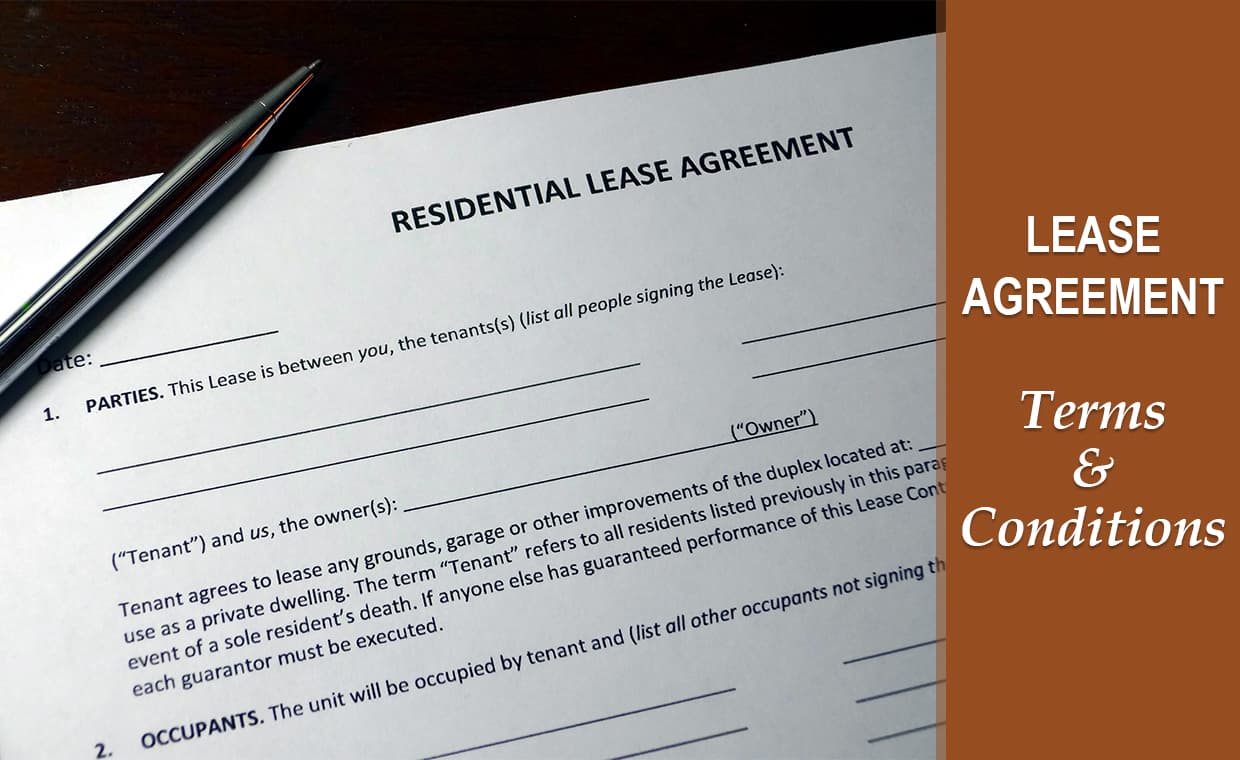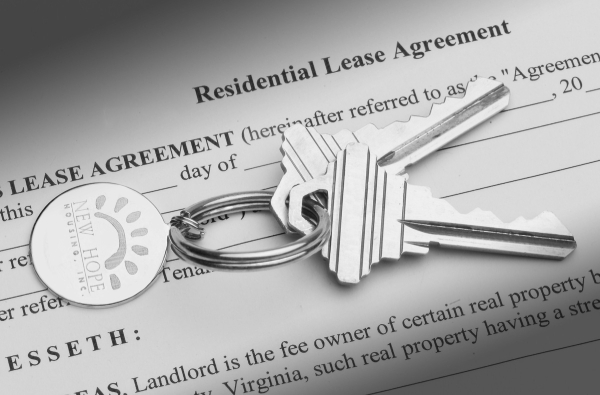
The demographics obtained by the National Multi-housing Council, US, from 2012 indicate that from total households, the renter occupied households’ make up approximately 32%. However this figures differs from region to region. For instance, city like Los Angeles has 42% and New York has 50% households in the rental stocks.
A lease agreement is one of the most important documents in the whole transaction. Even if you are a landlord or a tenant, it is crucial for both. So then the question arises – What is a lease agreement? Well, lease agreement is a legal agreement between the property owner and the tenant who occupies the space. It specifies a set of rules for the tenant who lives in the rented space. It also defines the outcomes which follow when the rules stated in the agreement are violated. In other words, according to the Oxford Dictionary “lease agreement is a contract by which one party conveys land, property, services, etc. to another for a specified time, usually in return for a periodic payment.”
Before discussing about the further terms and conditions of lease agreement, let us first understand in detail what is a Lease Agreement.
What is a Lease Agreement?
- A Lease agreement is a contract or an agreement between two parties (here a lessor and the lessee. Lessor is the owner of the property and the lessee is the one who is acquiring the property on lease) in which the set of rules and regulations are mentioned regarding leasing or renting of the property.
- This agreement gives a right to the lessee to occupy or use the property for a specific duration mentioned in it, but does not give him the right to own it.
- The house lease agreement consists of the specifications, instructions and conditions the lessor has laid down and accepted by both the parties during the occupancy or tenure of the lease.
- The Lease Agreement provides the landlords and the tenants a legally enforceable contract thereby providing security to both – the landlord and the tenant.
- A good rental lease agreement protects the interest of both the parties and prevents the misunderstanding that can lead to future hassles and disputes between both of them. In a city like Kolkata in India, a large number of old houses/buildings which were given on lease previously, their cases still lie pending in the court against the lessee since years. Such situation arises when things are not clarified specifically or no proper agreement is made at the time of deal.
- So, why are the legal cases filed against the lessee? This is because they refused to vacate or leave the property which was given to them on lease by the lessor.
Gharpedia has written articles pertaining to the same topic. To understand in detail regarding lease, please refer the articles mentioned in the links given below
Now let us discuss about the terms and conditions which are required to be specified in the lease agreement.
Terms and Conditions of Lease Agreement

A lease agreement should contain certain mandatory terms to make it agreeable to both the parties. It can be in any form, either handwritten or typed. Listed below are the important points that are commonly included in a lease agreement.
01. Names of All the Tenants in Lease Agreement
- The name/names of whoever going to use the property on lease should be mentioned as lessee.
- This will make all the tenants legally responsible for the terms and conditions which include payment of the full amount and proper use of the property.
- In case, one of the tenants is unable to pay the lease rental or if any tenant skips out, the lessor can legally sue the tenant and can collect the entire rental amount from the remaining tenants.
- Even if one of the tenants violate or break any important term described in the lease agreement, the owner can terminate the tenancy of all the tenants under that Lease Agreement, if provided in the agreement.
02. Occupancy Limits
- There should be a clear mention and proper description of property rented along with its details like area, dimensions including a map, etc.
03. Tenancy Tenure or Duration
- There should be a clear description in the agreement whether it is a fixed-term lease or a rental agreement.
- Rental agreements usually are for a month to month rental. They get automatically renewed until and unless terminated by the tenant or the landlord.
- Leases are generally for a period of one year or for a fixed duration.
- So, it is up to the owner to make the agreement flexible by not mentioning the period of Tenancy.
04. Rent Details

- The lease agreement should clearly state the amount of the rent to be paid, time limit for payment and mode of payment.
- In order to avoid confusions and disputes, it should also specify the acceptable payment methods. In case the rent is not paid in time, whether late fees should be levied or no, should any grace period be given or no, etc. shall be clearly mentioned in the agreement. It should also state penalty clause in case the cheque given for rent amount is not honored.
05. Security Deposit & Fees

- Between the lessor and the lessee, the aspect of use and return of security deposits is a common source of friction. To avoid legal hassles and confusion, the lease agreement should clearly state the limit, use and return of the deposits along.
- The amount to be paid as the security deposit.
How the lessor will utilize the deposit (say for example – he may use it for repair, maintenance works etc.)
- The mode and time of Return of the security deposit and the deduction/ refund of the amount after the tenant moves out.
- Any legal fees which are not refundable to the tenants.
- It is a good idea and, in some states and cities, it is required under legal provision to provide details regarding security deposit as to where shall be the security deposit kept and is there any interest payable on the security deposit or no.
- If interest is available, will it be passed on to the tenant or not?
06. Maintenance & Repair Works in Leased Property

- The responsibilities regarding maintenance and repair works should be set out and stated in the lease agreement by the lessor which may include.
- The responsibility of the lessee should include keeping and maintaining the premises of the leased property clean and in hygienic condition.
- Procedures to handle requests for complaints and repairs.
- Restriction on the repairs and alterations/ renovation according to the will of the lessee, such as adding a built-in dishwasher, installing burglar system or painting of the walls without the permission of the lessor.
07. Entry to the Property Given on Lease
- The lease agreement should clarify the legal rights of the lessor on the property so that the lessee can be sued for illegal entry or violation of any privacy rights.
08. Restrictions on Illegal Activity
- The clause should be included in the lease agreement prohibiting the disruptive and rude behavior such as excessive noise and illegal activities like drug dealing, etc.
- This clause is necessary to protect the lessee, to limit the exposure to lawsuits from the neighbors and also to prevent any damage to the property.
09. Pets Allowed or Not
- Whether pets are allowed or not in the premises should be clearly mentioned in the lease agreement.
- If they are allowed, the agreement should also specify the number of pets or the limit on the size of the pets in order to keep the premises of the lessor free from the animal waste.
10. Leased Property Taxes
- The lease agreement must clearly state to the local authority about the responsibility pertaining to pay property tax i.e. who is going to pay the property tax, the consequences to follow if the tax not paid at all or not paid in time.
11. Other Necessary Restrictions
Some other terms and conditions deemed useful to protect the property which may be included in lease agreement are listed below:
a) Right of Renewal of Lease by the Tenant:
Whether the tenant has the right to renew the lease at the end of the leasing period or not should also be listed in the lease agreement. Generally, when the lease period is renewed, a new lease agreement needs to be signed.
b) Parking Rules/Restrictions:
Is there any provision of parking in the property/ premises or is there any parking space offered at a designated spot? This also needs to be mentioned in the lease agreement.
c) Right to Sublet the Space:
It should be mentioned in the lease agreement whether the tenant has the right to sublet the premises/ property to another person or not.
d) Rules Regarding the Property:
If the property is a multi-unit, the landlord needs to set and specify the rules that govern the behavior on the property such as not doing vehicle repair works in the parking lot or no loud noises after 10 pm and so on.
e) Activities Allowed:
Activities ‘allowed’ and ‘not allowed’ to the tenant should be specifically listed out in the agreement. In case there are activities allowed to the tenant, the consequences should also be specified if damage occurs due to the same.
There are various standardized and printed basic lease agreement forms available which may or may not include vital and optional terms and conditions in it. It is not necessary that the standardized agreements always fit in the way you want. The standardized agreement may or may not fit as per your requirement as a lessor or property owner. However, the best way to customize the lease agreement is by taking the help of a real estate lawyer. A well-defined and clear-cut Lease Agreement will help you and your tenant to live peacefully, without any conflicts during the tenancy period.
Hope this article has provided you with the knowledge regarding lease agreement and the terms and conditions which needs to be included in it. If you think we have missed out anything or if you are keen to share your views on this topic, please do it by commenting in the box given below.
The blogs mentioned below are pertaining to the related topic:
Know the Difference Between Lease and License!
Landlord’s Guide for Renting to Tenants with Bad Credit!
Image Courtesy: Image 4


































